#Fermented wheat
Explore tagged Tumblr posts
Text

GBBO contestants, trying to braid a loaf of bread: [panic, chaos, gnashing of teeth]
me, Jewish, popping out my ninth braided loaf in three weeks as the new year holidays trundle inexorably on: what, like it's hard?
#this is a little mean spirited but so was the expulsion of 1290#im willing to call it even if they are#no one ask me about caramel or tempering chocolate—#i know Paul hates it when loaves stretch apart like this#but i think it's beautiful#a reminder of the life and elemental vigor of wheat and yeast and fermentation and fire#my preferred form of kitchen witchery#ḥag saméi'aḥ!
11 notes
·
View notes
Text
i was telling PB this but it's weird that seitan became the loanword for wheat gluten instead of mianjin. and according to wikipedia's history section, seitan wasn't even coined until the 60s and was imported to the US by Erwhon of all stores... it's all making sense now. but I stand with the chinese
#and seitan seems to only refer to the steak formation of wheat gluten#where mianjin can be fried into gluten balls or fermented and then steamed#kinda wanna try the former but i don't have a thermometer and deep frying scares me
4 notes
·
View notes
Text
Siddhu vs Momos: Discover the Nutrient-Rich Treasure of Himachal
#fermented wheat dishes#healthy Indian dishes#Himachal cuisine#Himachal superfood#Himachali food#Indian street food alternatives#momo vs Siddhu#Siddhu Himachal#Siddhu recipe#steamed food India#traditional Indian food#wheat flour recipes
0 notes
Text
i love beer im naming my next dog ninkasi
0 notes
Text
oh my god i figured it out
okay so it took an accident of me not checking on it, but I FINALLY figured out why I wasn't getting enough loft on my bread:
I was NOT giving enough time for yeast/bacteria production.
So if I do my other bread recipe's 4 hour levain development, then follow the pullman's recipe and do about an hour and a half initial rise (with stretch and folds) with a one hour final rest and rise, I get something like this:
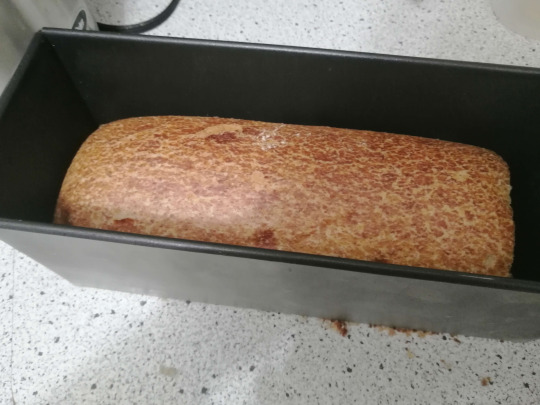
okay that rose in the oven but like. not a whole lot, yknow?
tried again, a little longer on the levain, but this time I tried to do the final rest/rise in the fridge overnight like when you have an overnight ferment on a classic sourdough
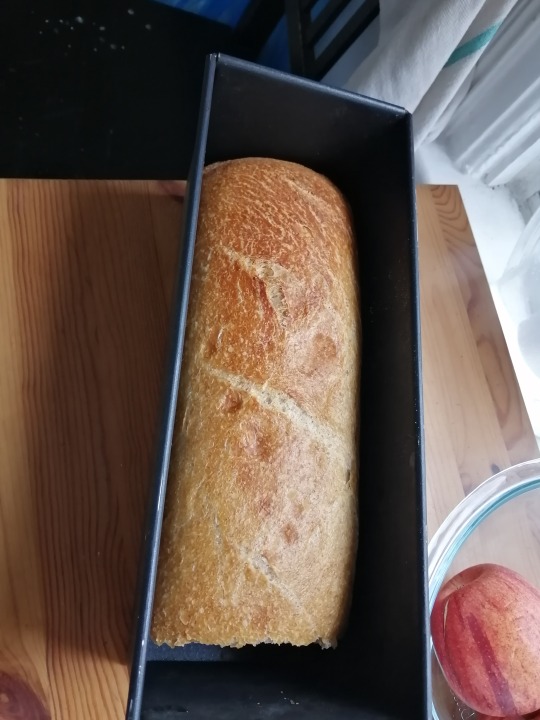
oh that's a lot better! but the recipe is for a PULLMAN'S loaf, it should be square as possible, am I using enough ingredients?
NO I WAS. I JUST WASNT GIVING ALL THE TIMES ENOUGH TIME
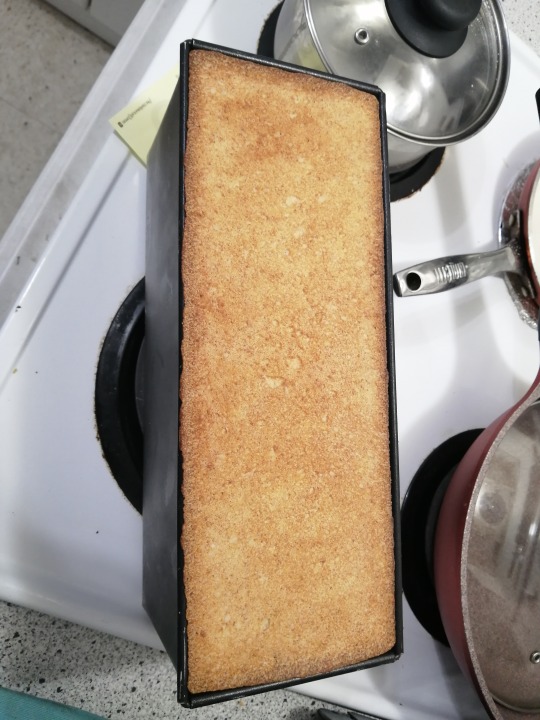
this time I let the levain (40-50g starter, 35g whole wheat flour, 35g AP flour, 70 mL water) develop for like six and a half hours in a proofer or a slightly warmed oven.
pour levain into a stand mixer if you've got one, bowl if you dont. Mix in sugar (35g) and warm water (400mL). Let that sit for the usual half hour in proofer.
add flour (600ish grams total, i often do about a third whole wheat to two thirds AP), 5g salt, 80-90g fat of choice (butter, margarine, etc). I put it in the stand mixer for around 10 minutes on low. (this is a REALLY old stand mixer so it CAN go real slow- do 7-8 min on lowest setting on a modern mixer, 15 min if you wanna do a hand knead)
cover and put in proofer. As usual I did 4 stretch and folds at half hour intervals, but on the final interval I forgot about the timer- it was left in the bowl for around a full hour after the last fold rather than the planned half hour.
by the time I checked on it, it rose WAY more than i was expecting it to. Decided to roll with it (lol), greased the pullman's pan (butter if no one's allergic, margarine otherwise), flattened, rolled up the dough, plopped it in and slid on the lid.
Did the final rest for two full hours in proofing temps, then baked at 350-60ish for a half hour with the lid slid on, 15 min with the lid off.
so, all in all: the ideal loaf of pullman's sourdough starts when you wake up and comes out around dark lunch.
not practical but hey! an interesting study to be sure
2K notes
·
View notes
Note
Why did wheat become a widespread staple crop given that it's difficult to harvest/transport/etc? This is not meant to be snarky or combative in any way, it's a genuine question. Are there any books you'd recommend for learning more about this kind of economic and technological history? Thanks.
sorry, i've long since forgotten all the actual books i've read about it, but i will always recommend This Guy:
also as very much a non-expert, my semi-informed opinion on Wheat is that growing complicated and difficult compared to going to the grocery store, and doesn't stack up very well to living in a food forest like north and south americans managed, either.
however, wheat is a grass, and grass grows in a lot of places that people also like to live in, and so wheat farming isn't as crazy a venture as it might otherwise seem.
in a lot of climates, it's possible to plant the grass, harvest the grass seeds, and store the seeds long enough to get you through the part of the year where there's nothing much to eat. if you manage your social and material technology right, you can store a lot of the seeds, and you can even transport them around before they rot, meaning you can now export the seeds from places where grass grows into places where it doesn't. the stalks of the grass that you can't eat provides food for the animals you need to help you grow the grass. and transport the seeds, too.
the social structure required to grow wheat in bulk (a steep and violent hierarchy) does three things: feeds everyone in it with enough extra that the guys on the bottom of the organization can survive to grow more wheat next year, and allows the guys on the top can sequester the rest as profit, consolidating their power. the third thing is that as land is converted to wheat fields, it stops yielding any other food but wheat, which locks people into the system for good. once a people depend on a staple cereal grain for their main source of calories, there isn't an easy way back: forests are chewed away for more wheat fields and those woodlands that remain are shifted towards hardwoods for agricultural tools, rather than food forests with fruit/nuts/shrubs, and even those maintained as game preserves still can't support the needs of entire villages.
in arid and semi-arid conditions, it's even harder to step away from dependence on grain farming because there the agricultural development is along rivers where the land can be irrigated, and the population of people supported by grain production is extremely concentrated into those small areas rather than spread across the entire biome.
in the northern parts of eurasia where grain couldn't be produced at scale because it was too rocky and too cold, people mostly went fishing, and when they grew stuff it was hardy root crops like beets and turnips.
DISCLAIMER: this is all very approximate. but now you know as much as i know.
P.S actually here's the last thing about wheat: it probably all started as a way to reliably source and produce beer, which was invented a long time before bread. bread was invented from wheat when the guys who were producing the beer seeds wanted to start exporting beer seeds to people who wanted beer far away, so they baked the seeds into tablets you could easily transport and then ferment with water once you got to your destination. eventually the traders who were transporting the beer kits started eating them, too, and crackers as a snack food really took off. look up the wikipedia article on beer if you don't believe me.
#wheat#agriculture#you want kings? that's how you get kings#you start out just wanting to source some beer reliably#then you fucking get kings#what a racket
250 notes
·
View notes
Note
theres a lot of wild peafowl near where i live. if i wanted to feed them, would it be an alright thing to do, and what should i feed them?
Wild or feral? it makes a difference.
If you live in part of the world where there are legit wild peafowl, please leave them alone, as you do not want to habituate them to human interaction.
If you live where there are feral peafowl (like florida or cali or something), then it's fine to feed them! It is best to offer them protein- feeder insects, feeder mouse pinkies, feeder fish, raw shrimp, raw fish, roasted peanuts (a favorite, but give them human-grade peanuts, not bird peanuts, to avoid the risk of aflatoxins). I wouldn't give domestic meats right now, given the H5N1 issues abounding, but usually you'd be able to offer cooked domestic meats (beef, chicken, turkey, lamb, etc). You can also give them chopped fruits (grapes, strawberries, melons, tomatoes, pomegranate, cucumber, etc), EXCEPT no avocado, or whole (watermelon is beloved in the summer!), and you can TRY chopped veggies but they... are not terribly fond of most veggies. Big hard ones like squash/zucchini are usually well received, and they will eat a bag of frozen veggies (particularly peas) if you can find a bag with no/low sodium. You can give whole leafy greens (kale, spinach, dark green romaine, leaf lettuce, collard greens etc), but these are usually best tied up to something so they can rip off pieces, like a stake. You can get whole grains and seeds- black oil sunflower seeds are valued highly by them. Whole corn can be given in modertion. Safflower, wheat, milo, rice (cooked or uncooked), popcorn. Barley and oats are not great for them due to the way they process. Cooked pasta and cooked potatoes are fan favorites, but should be given in moderation (spiral pasta is beloved here, mixed into a pasta salad of other stuff they can have). Lastly, suet nugget treats are the absolute favorite treat for EVERY bird I own. All of the other treats have at least one bird that doesn't really give a shit about it. there are NO birds that don't SCRAMBLE to eat suet nuggets, and berry flavor is the favorite. If you have the space for it, you can pick up a bag of good quality high-protein turkey starter (NOT purina) and give them a bowl of it after you've added water to make it soft/ferment it a little. They ALSO all unilaterally love this treat, and it's really good for them (unlike the nugget treats).
Please do NOT give them garlic or onions (allicin isn't great for them), cabbage during spring/summer months (too high in oxalates when they need calcium), avocado, chocolate, dairy products, bread, or cat food (or other dry pet foods). If you're uncertain about something you want to try, feel free to message me!
201 notes
·
View notes
Text
Plant-Based Foods and Beverages and Their Zodiac Correspondences

Aries: onions, garlic, hot mustard, rhubarb, salsa, curry
Taurus: beans, confectionery, chocolate, wheat
Gemini: walnuts, hazelnuts, coffee, tea, carrots, buckwheat, lettuce
Cancer: sesame oil, melons, avocados
Leo: almonds, sunflower seeds, saffron rice, bourbon, honey, olives
Virgo: wheat, bread, corn, sassafras, green tea
Libra: confectionery, chocolate, strawberries, apricots, raspberries, apples
Scorpio: mushrooms, artichokes, pomegranates, fermented products
Sagittarius: chestnuts, maple syrup, asparagus, tomatoes
Capricorn: barley, beer, hops, potatoes, beets, dried fruit, spinach
Aquarius: coffee, cinnamon, sparkling drinks such as champagne
Pisces: water, wine, watercress, seaweed
- Magickal Astrology by Skye Alexander
114 notes
·
View notes
Text
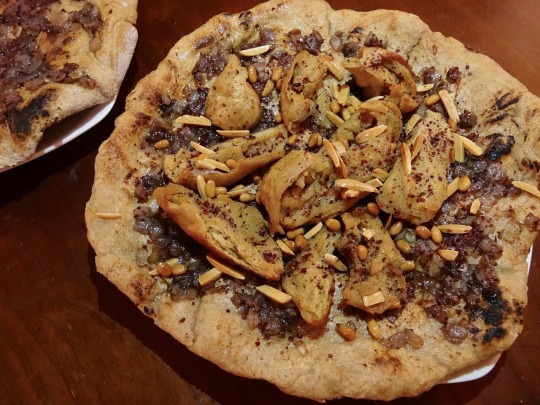

[ID: Two large flatbreads. The one in the center is topped with bright purple onions, faux chicken, fried nuts, and coarse red sumac; the one at the side is topped with onions and sumac. Second image is a close-up. End ID]
مسخن / Musakhkhan (Palestinian flatbread with onions and sumac)
Musakhkhan (مُسَخَّن; also "musakhan" or "moussakhan") is a dish historically made by Palestinian farmers during the olive harvest season of October and November: naturally leavened flatbread is cooked in clay ovens, dipped in plenty of freshly pressed olive oil, and then covered with oily, richly caramelized onions fragrant with sumac. Modern versions of the dish add spiced, boiled and baked chicken along with toasted or fried pine nuts and almonds. It is eaten with the hands, and sometimes served alongside a soup made from the stock produced by boiling the chicken. The name of the dish literally means "heated," from سَخَّنَ "sakhkhana" "to heat" + the participle prefix مُـ "mu".
I have provided instructions for including 'chicken,' but I don't think the dish suffers from its lack: the rich, slightly sour fermented wheat bread, the deep sweetness of the caramelised onions, and the true, clean, bright expressions of olive oil and sumac make this dish a must-try even in its original, plainer form.
Musakhkhan is often considered to be the national dish of Palestine. Like foods such as za'tar, hummus, tahina, and frika, it is significant for its historical and emotional associations, and for the way it links people, place, identity, and memory; it is also understood to be symbolic of a deeply rooted connection to the land, and thus of liberation struggle. The dish is liberally covered with the fruit of Palestinian lands in the form of onions, olive oil, and sumac (the dried and ground berries of a wild-growing bush).
The symbolic resonance of olive oil may be imputed to its history in the area. In historical Palestine (before the British Mandate period), agriculture and income from agricultural exports made up the bulk of the economy. Under مُشَاعْ (mushā', "common"; also transliterated "musha'a") systems of land tenure, communally owned plots of land were divided into parcels which were rotated between members of large kinship groups (rather than one parcel belonging to a private owner and their descendants into perpetuity). Olive trees were grown over much of the land, including on terraced hills, and their oil was used for culinary purposes and to make soap; excess was exported. In the early 1920s, Palestinian farmers produced 5,000 tons of olive oil a year, making an average of 342,000 PL (Palestinian pounds, equivalent to pounds sterling) from exports to Egypt alone.
During the British Mandate period (from 1917 to 1948, when Britain was given the administration of Palestine by the League of Nations after World War 1), acres of densely populated and cultivated land were expropriated from Palestinians through legal strongarming of and direct violence against, including killing of, فَلّاَحين (fallahin, peasants; singular "فَلَّاح" "fallah") by British troops. This continued a campaign of dispossession that had begun in the late 19th century.
By 1941, an estimated 119,000 peasants had been dispossessed of land (30% of all Palestinian families involved in agriculture); many of them had moved to other areas, while those who stayed were largely destitute. The agriculturally rich Nablus area (north of Jerusalem), for example, was largely empty by 1934: Haaretz reported that it was "no longer the town of gold [i.e., oranges], neither is it the town of trade [i.e., olive oil]. Nablus rather has become the town of empty houses, of darkness and of misery". Farmers led rebellions against this expropriation in 1929, 1933, and 1936-9, which were brutually repressed by the British military.
Despite the number of farmers who had been displaced from their land by European Jewish private owners and cooperatives (which owned 24.5% of all cultivated land in Palestine by 1941), the amount of olives produced by Palestinians increased from 34,000 tons in 1931 to 78,300 in 1945, evidencing an investment in and expansion of agriculture by indigenous inhabitants. Thus it does not seem likely that vast swathes of land were "waste land," or that the musha' system did not allow for "development"!
Imprecations against the musha' system were nevertheless used as justification to force Palestinians from their land. After various Zionist organizations and militant groups succeeded in pushing Britain out of Palestine in 1948—clearing the way for hundreds of thousands of Palestinians to be dispossessed or killed during the Nakba—the Israeli parliament began constructing a framework to render their expropriation of land legal; the Cultivation of Waste Lands Law of 1949, for example, allowed the requisition of uncultivated land, while the Absentees’ Property Law of 1950 allowed the state to requisition the land of people it had forced from their homes.
Israel profited from its dispossession of millions of dunums of land; 40,000 dunums of vineyards, 100,000 dunums of citrus groves, and 95% of the olive groves in the new state were stolen from Palestinians during this period, and the agricultural subsidies bolstered by these properties were used to lure new settlers in with promises of large incomes.
It also profited from the resulting "de-development" of the Palestinian economy, of which the decline in trade of olive oil furnishes a striking example. Palestinian olive farmers were unable to compete with the cheaper oils (olive and other types) with which Zionist, capital-driven industry flooded the market; by 1936, the 342,000 PL in olive oil exports of the early 1920s had fallen to 52,091 PL, and thereafter to nothing. While selling to a Palestinian captive market, Israel was also exporting the fruits of confiscated Palestinian land to Europe and elsewhere; in 1949, olives produced on stolen land were Israel's third-largest export. As of 2014, 12.9% of the olives exported to Europe were grown in the occupied West Bank alone.
This process of de-development and profiteering accelerated after Israel's military seizure of the West Bank and Gaza in 1967. In 1970, agriculture made up 34% of the GDP of the West Bank, and 31% of that of Gaza; in 2000, it was 16% and 18%, respectively. Many of those out of work due to expropriated or newly unworkable land were hired as day laborers on Israeli farms.
Meanwhile, Palestinians (and Israeli Palestinians) continued to plant and cultivate olives. The fact that Palestinians do not control their own water supplies or borders and may expect at any time to be barred by the military from harvesting their fields has discouraged investment and led to risk aversion (especially since the outmoding of the musha' system, which had minimized individual risk). In this environment, olive trees are attractive because they are low-input. They can subsist on rainwater (Israel monopolizes and poisons much of the region's water, and heavily taxes imports of materials that could be used to build irrigation systems), and don't require high-quality soil or daily weeding. Olive trees, unlike factories and agricultural technology, don't need large inputs of capital that stand to be wasted if the Israeli military destroys them.
Olive trees are therefore the chosen crop when proving a continued use of land in order to prevent the Israeli military from expropriating it under various "waste" or "absentee" land laws. Palestinians immediately plant olive seedlings on land they have been temporarily forced from, since even land that has lain fallow due to status as a military closed zone can be appropriated with this justification. The danger is so pressing that Palestinian agronomists encouraged this habit (as of 1993), despite the fact that Israeli competition and continual planting had lowered olive crop prices, and despite the decline in soil quality that results from never allowing land to lie fallow. In more recent years, olive trees have yielded primary or supplementary income for about 100,000 Palestinian families, producing up to 191 million USD in value in good years (including an average of 17,000 tons of olive oil yearly between 2001 and 2009).
Israeli soldiers and settlers have famously uprooted, vandalized, razed, and burned millions of these olive trees, as well as using military outposts to deny Palestinian farmers access to their olive crops. It prefers to restrict Palestinians to annual crops, such as vegetables and grains, and eliminate competition in permanent crops, such as fruit trees.
This targeting of olive trees increases during times of intensified conflict. During the currently ongoing olive harvest season (November 2023), Gazan olive farmers have reported being targeted by Israeli war planes; some farmers in the West Bank have given up on harvesting their trees altogether, due to threats issued by organized networks of settlers that they would kill anyone seen making the attempt.
The rootedness of olive trees in the history of Palestine gives them weight as a symbol of homeland, culture, and the fight for liberation. Palestinian olive harvest festivals, typically celebrated in October with singing, dancing, and eating, have inspired similar events elsewhere in the world, aimed at sharing Palestinian food and culture and expressing solidarity with those living under occupation.
Support Palestinian resistance by calling Elbit System’s (Israel’s primary weapons manufacturer) landlord, donating to Palestine Action’s bail fund, and donating to the Bay Area Anti-Repression Committee bail fund.
Ingredients:
For the dish:
2 pieces taboon bread, preferably freshly baked
2 large or 3 medium yellow onions (480g)
1 cup first cold press extra virgin olive oil (زيت زيتون البكر الممتاز)
1 Tbsp coarsely ground Levantine sumac (سم��ق شامي / sumaq shami), plus more to top
Ground black pepper
For the chicken (optional):
500g chicken substitute
5 green cardamom pods, or 1/4 tsp ground cardamom
4 cloves, or pinch ground cloves
1 Mediterranean bay leaf
1 Tbsp ground sumac
For the nut topping (optional):
2 Tbsp slivered almonds
2 Tbsp pine nuts
Neutral oil, for frying

Notes on ingredients:
Use the best olive oil that you can. You will want oil that has some opacity to it or some deposits in it. I used Aleppo brand olive oil (7 USD a liter at my local halal grocery).

If you want to replace the taboon bread with something less laborious, I would recommend something that mimics the rich, fermented flavor of the traditional, whole-wheat, naturally leavened bread. Many people today make taboon bread with white flour and commercial yeast—which you might mimic by using storebought naan or lavash, for example—but I think the slight sourness of the flatbread is a beautiful counterpoint to the brightness of the sumac and the sweetness of the caramelized onions. I would go with a sourdough pizza crust or something similar.
Your sumac should be coarsely ground, not finely powdered; and a deep, rich red, not pinkish in color (like the pile on the right, not the one on the left).

For this dish, a whole chicken is usually first boiled (perhaps with spices including bay leaves, cardamom, and cloves) and then baked, sometimes along with some of the oil from frying the onions. I call for just frying or baking instead; in my opinion, boiling often has a negative effect on the texture of meat substitutes.
Instructions:
For the onions:
1. Heat a cup of olive oil in a large skillet or pot. Fry onions on medium-low, stirring often, for 10 minutes or until translucent.

2. Add 1 Tbsp sumac and a few cracks of black pepper and reduce to low. Cook for another 30 minutes, stirring occasionally, until onions are sweet, reduced in volume, and pinkish in color.

For the chicken:
1. Briefly toast and finely grind spices except for sumac (cardamom, cloves, and bay leaf). Filter with a fine mesh sieve. Dip 'chicken' into the pot in which you fried the onions to coat it with olive oil, then rub spices (including sumac) onto the surface.
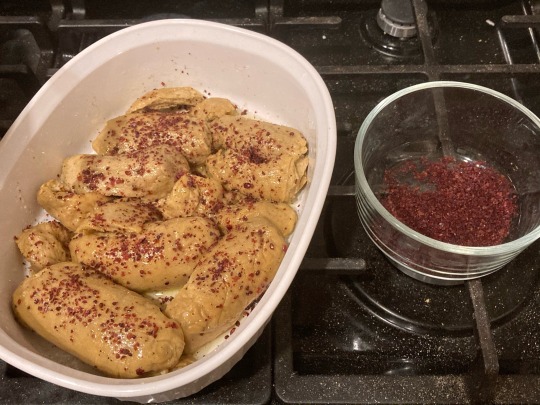
2. Sear chicken in a dry skillet until browned on all sides; or bake, uncovered, in the top third of an oven heated to 400 °F (200 °C) until browned.
For the nut topping:
1. Heat a neutral oil on medium in a small pot or skillet. Add almonds and fry for 2 minutes, until just starting to take on color. Add pine nuts and fry until both almonds and pine nuts are golden brown. Remove with a slotted spoon.
To assemble:
1. Dip each flatbread in the olive oil used to fry the onions, then spread onions over the surface.
Some cooks dip the bread entirely into oil; others press it lightly into the surface of the oil in the pot on both sides, or one side; a more modern method calls for mixing the olive oil with chicken broth to lighten it. Consult your taste. I think the bread from my taboon recipe stands up well to being pressed into the oil on both sides without tearing or becoming soggy.
2. Top flatbread with chicken and several large pinches more sumac. Bake briefly in the oven (still heated to 400 °F / 200 °C), or broil on low, for 3-5 minutes, until the sumac and the surface of the bread have darkened a shade.
3. Top with fried nuts.
Musakhkhan is usually eaten by ripping the chicken into bite-sized pieces, tearing off a bit of bread, and eating the chicken using the bread.
Some cooks make a layered musakhkhan, adding two to three pieces of bread covered with onions on top of each other before topping the entire construction with chicken and pine nuts.
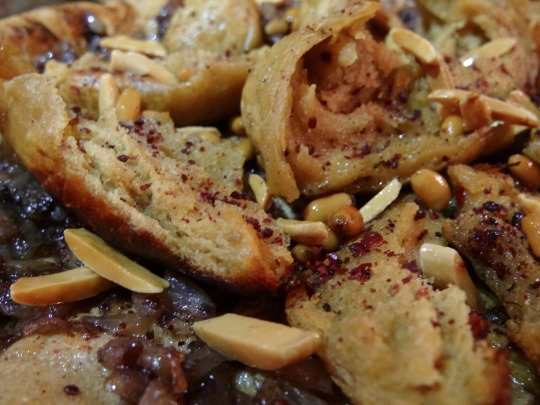
820 notes
·
View notes
Text
Bread from the Hollow: A Mountain Witch’s Sourdough Spell 🍞
Lately, I’ve been downright beside myself with everything sourdough—can’t get enough of it. My house has turned into a full-blown mountain bakery, with flour dusting every surface and loaves rising like quiet prayers in every warm corner. I’ve been handing out bread loaves like love notes, tucking warm rounds into the arms of folks I love, each one a blessing wrapped in brown paper and sealed with a "Made With Love" sticker. And like any true mountain witch, I’ve been folding my magic into the dough—sealing every loaf with workings of Nourishment, Prosperity, and Protection.
In the old mountain ways, the hearth was the heart of the home—and the kitchen, a place where magic and meal danced together in the same pot. The Granny witches of these hills knew food fed more than the belly—it fed the bones, the heart, the soul. Prayers were pinched into biscuits, healing stirred slow into stews, and intention rose right alongside the dough.
Bread, most of all, held a certain power. Sacred and sustaining, it carried the alchemy of time, patience, and hands that know. It brings to mind that line from the movie Red Riding Hood (2016), when the old grandmother says, “All sorrows are lessened with bread.” Ain’t that the truth? There’s something in a loaf—humble and golden—that soothes grief, mends tired hearts, and reminds us we still belong to something warm and good.
The rise of the dough ain’t just science—it’s a slow kind of resurrection. A fermentation of hope.
So, this here is my sourdough bread spell—born of love, flour, and fire. It calls on the element of Earth to ground, the element of Fire to transform, and the living, breathing spirit of fermentation to wake what’s been lying dormant. Like any true cunning magic, it’s both spell and sustenance, meant to bless the body and charm the soul.
May your hands stay warm, your belly stay full, and your spirit never go without.

---------🍞---------🍞---------🍞---------🍞---------
Sourdough Spell for Nourishment, Prosperity, and Protection
(For one loaf)
🌾 Magical Ingredients & Their Witchery
Sourdough Starter – Your living familiar. A spirit in a jar. Represents legacy, renewal, and transformation. Carries your energy over time. Feed it like kin.
Flour – The body of the spell. Represents abundance, stability, and foundation. Choose with care. Wheat flour ties to old harvest rites.
Water – The connector. Binds and activates. Use clean or blessed water. Represents intuition, flow, and emotional nourishment.
Salt – The protector. Banishes unwanted energies and holds the spirit of the bread intact. Represents boundaries, purification, and grounding.
Time (fermentation) – The unseen worker. Represents patience, transformation, and the will to become.
Fire (baking) – The final spellwork. Transforms potential into being. Represents will, passion, and manifestation.
Sourdough Recipe:
120 grams sourdough starter
400 grams of flour
250 grams of warm water
9 grams of salt

---------🍞---------🍞---------🍞---------🍞---------
Working The Spell
1. Morning Intention
Before you begin, light a candle near your prep space. Wash your hands in cool water with a pinch of salt to clear your energy. Speak aloud:
"As I mix, I mend. As I knead, I weave. As I bake, I bless."
2. Mixing the Dough
Combine your starter, flour, water, and salt in a large bowl. As you stir, chant softly or silently:
"Flour and water, womb of stone,
Feed the spirit, flesh, and bone.
Salt to shield, and time to bless—
May all I need come to possess."
Focus on your intention: Are you baking for strength? For protection? For steady income? Pour that into your hands as you knead.
3. Folding & Fermenting
Every time you fold your dough, whisper a small charm. You might say:
"Rise with power, rise with grace,
Bless this home, this heart, this place."
Cover the dough and leave it to rest. Let the spirit of fermentation do its quiet magic... I do let my loaves ferment overnight in the fridge.

---------🍞---------🍞---------🍞---------🍞---------
✒️ Scoring the Sigil
When your dough is ready for baking, dust the top with flour and score it with a blade. This is where you carve your sigil of intent—it can be a simple crossroads ( + ) for protection, a rune for wealth, or your own mark created for this working.
As you score, say:
"By cut and curve, I shape this spell—
Let all be done, and all be well."

I chose a crossroads symbol for protection.
---------🍞---------🍞---------🍞---------🍞---------
🔥 Baking the Bread
Slide your loaf into the hot oven. As it bakes, sit with the scent. Visualize your intent rising and solidifying in the world. Let it fill your space with warmth and quiet power.
When the loaf is done and cooled, hold it in your hands. Say:
"From flame and flour, crust and crumb,
The spell is sealed. So, mote it becomes."
Wrap it up and then share it—or savor it—as an act of sacred nourishment.
---------🍞---------🍞---------🍞---------🍞---------
When you pull that golden loaf from the oven, know this, darlin’—you’ve stirred up a quiet kind of wonder. You’ve fed more than just belly-hunger; you’ve nourished spirit and home, weaving care into every crumb and tucking a bit of spellcraft into the crust. This one’s for you, reader—a gift from my hearth to yours, baked up with magic and love. May each slice bring you comfort and blessing, and may your hearth never be without warmth, wonder, or witchery.
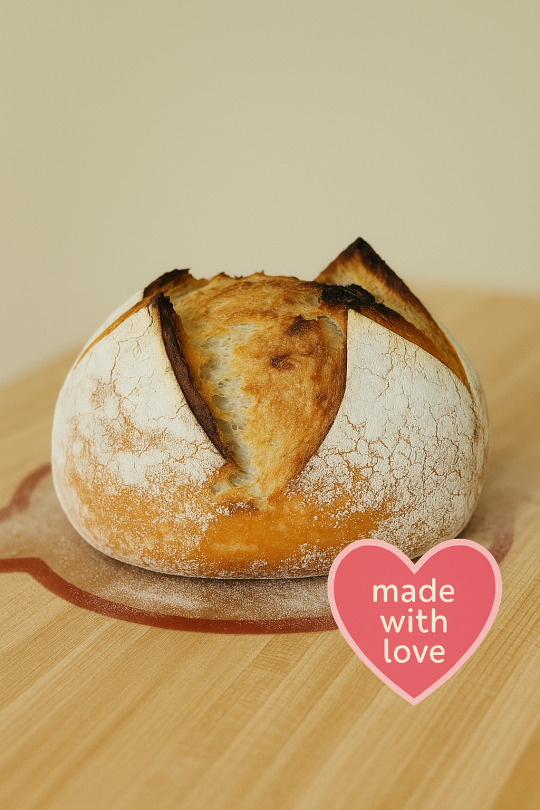
#witchcraft#witch#traditional witchcraft#folk witchcraft#witchblr#appalachian witch#appalachian magic#kitchen witch#kitchen magic#sourdough#bread making
56 notes
·
View notes
Text
Since I'm vegan, incorporating elements of a canine ancestral diet into my lifestyle will be more about emulating the nutritional balance rather than the exact foods wolves consume. Wolves eat a mix of proteins, fats, and plant matter, with an emphasis on whole, nutrient-dense sources. Their diet is built for survival, strength, and endurance—qualities I can mirror through plant-based foods while maintaining my values.
### **Key Elements of a Wolf's Diet & Vegan Alternatives**
#### **1. High-Protein Intake**
Wolves thrive on a protein-rich diet, which fuels their muscles and sustains their energy for long periods. You can incorporate:
- **Legumes & Pulses** – Lentils, chickpeas, black beans, and split peas
- **Soy-based Proteins** – Tofu, tempeh, and edamame
- **Seitan (Vital Wheat Gluten)** – A high-protein, meat-like option
- **Hemp & Chia Seeds** – Packed with complete proteins
- **Nutritional Yeast** – Adds protein and a cheesy flavor to dishes
#### **2. Balanced Fats for Energy & Brain Function**
Wolves get essential fatty acids from prey, but you can substitute with plant-based sources:
- **Omega-3s** – Flaxseeds, walnuts, algae-based supplements, hemp seeds
- **Healthy Fats** – Avocados, olives, coconut, and nuts
- **Medium-Chain Triglycerides (MCTs)** – Found in coconut oil, which can boost energy like animal fats do for wolves
#### **3. Micronutrients & Minerals from Wild Plants**
Wolves eat berries, grasses, and herbs instinctively to maintain their health. You can add these:
- **Berries** – Blueberries, blackberries, and raspberries for antioxidants
- **Leafy Greens** – Kale, spinach, dandelion greens (high in calcium and iron)
- **Herbs & Wild Edibles** – Nettles, burdock root, and spirulina for detoxifying and nutrient density
#### **4. Gut Health & Digestion**
Wolves consume organ meats and bones for vitamins and minerals. A vegan version includes:
- **Fermented Foods** – Sauerkraut, kimchi, miso, and kombucha for gut health
- **Seaweed** – Rich in iodine and minerals, similar to nutrients found in animal organs
- **Mushrooms** – Reishi, lion’s mane, and chaga mimic the adaptogenic benefits of organ meats
#### **5. Cyclical Eating & Fasting**
Wolves don’t eat constantly; they gorge, fast, and graze on small plant foods. You might try:
- **Intermittent Fasting** – Eating within a set window (e.g., 8-hour feeding period)
- **Feast & Fast Cycle** – Some days with high intake, some days lighter with just fruits and greens
- **Instinctual Eating** – Listening to your body’s needs rather than forcing strict meal times
#### **6. Hydration & Natural Electrolytes**
Wolves get hydration from prey and fresh water sources. For you:
- **Coconut Water** – A natural electrolyte boost
- **Herbal Teas** – Dandelion, mint, and chamomile for hydration and benefits
- **Infused Waters** – Lemon, cucumber, or berries to mimic mineral-rich natural waters
### **Meal Ideas Inspired by a Canine Ancestral Diet**
- **"Hunt & Gather" Bowl** – Lentils, roasted mushrooms, wild rice, dandelion greens, and tahini
- **High-Protein Wild Plate** – Grilled tempeh, hemp seed pesto, roasted root veggies
- **Feral Smoothie** – Blueberries, coconut milk, hemp protein, chia, and spirulina
- **Forager’s Broth** – Miso soup with seaweed, tofu, and mushrooms
- **Raw Energy Bites** – Dates, walnuts, cacao, flax, and a touch of sea salt
I'm a nerd and a vegan wolf so have my collected information and brainstorming
#therian#therianthropy#therian things#wolf therian#wolfkin#canine therian#caninekin#canine theriotype#dogkin#alaskan black wolf#diet#canine eats
57 notes
·
View notes
Text
DIONYSUS; A GUIDE TO WORSHIP
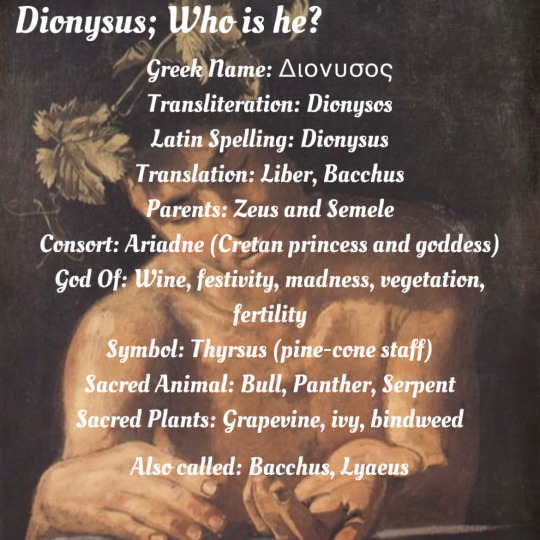
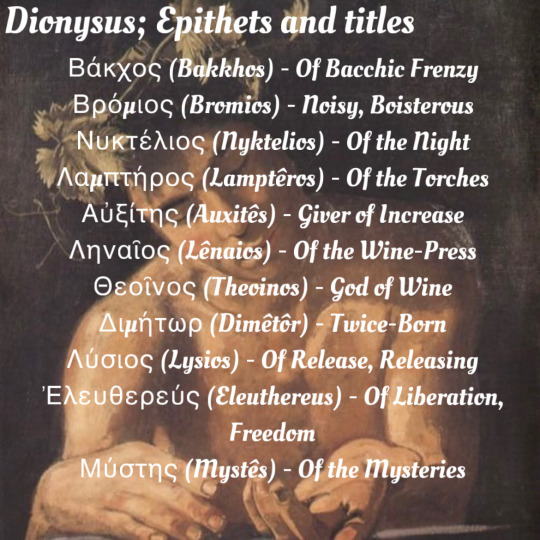
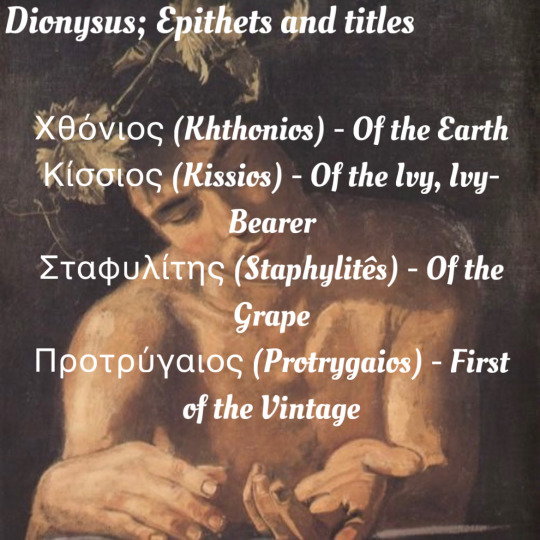
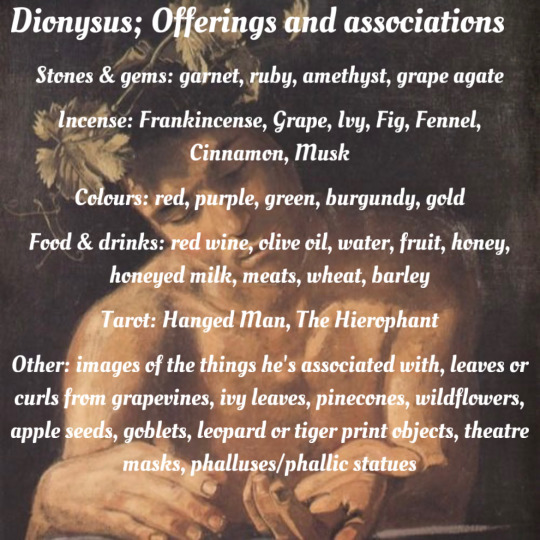


TEXT BELOW;
Dionysus;
Greek Name: Διονυσος
Transliteration: Dionysos
Latin Spelling: Dionysus
Translation: Liber, Bacchus
Parents: Zeus and Semele
Consort: Ariadne (Cretan princess and goddess)
God Of: Wine, festivity, madness, vegetation, fertility
Symbol: Thyrsus (pine-cone staff)
Sacred Animal: Bull, Panther, Serpent
Sacred Plants: Grapevine, ivy, bindweed
Also called: Bacchus, Lyaeus
Epithets and titles;
Βάκχος (Bakkhos) - Of Bacchic Frenzy
Βρόμιος (Bromios) - Noisy, Boisterous
Νυκτέλιος (Nyktelios) - Of the Night
Λαμπτήρος (Lamptêros) - Of the Torches
Αὐξίτης (Auxitês) - Giver of Increase
Ληναῖος (Lênaios) - Of the Wine-Press
Θεοῖνος (Theoinos) - God of Wine
Διμήτωρ (Dimêtôr) - Twice-Born
Λύσιος (Lysios) - Of Release, Releasing
Ἐλευθερεύς (Eleuthereus) - Of Liberation, Freedom
Μύστης (Mystês) - Of the Mysteries
Χθόνιος (Khthonios) - Of the Earth
Κίσσιος (Kissios) - Of the Ivy, Ivy-Bearer
Σταφυλίτης (Staphylitês) - Of the Grape
Προτρύγαιος (Protrygaios) - First of the Vintage
Offerings and associations;
Stones & gems: garnet, ruby, amethyst, grape agate
Incense: Frankincense, Grape, Ivy, Fig, Fennel, Cinnamon, Musk
Colours: red, purple, green, burgundy, gold
Food & drinks: red wine, olive oil, water, fruit, honey, honeyed milk, meats, wheat, barley
Tarot: Hanged Man, The Hierophant
Other: images of the things he's associated with, leaves or curls from grapevines, ivy leaves, pinecones, wildflowers, apple seeds, goblets, leopard or tiger print objects, theatre masks, phalluses/phallic statues
Historical worship;
Patron of regions;
Boeotia; Naxos;
Edonia in Western Thrace
Holiest shrine;
Mt Kithairon (Nysa) in Boeotia, Greece (site of Bacchic orgies)
Other shrines;
Temples throughout Greece
& Asia Minor
Honoured in fertility & harvest rituals
Known festivals:
Great Dionysia - a large festival celebrated in Athens
Anthesteria - festival celebrated in Attica and lonia around the time of the January or February full moon.
Lenaia - a dramatic
competition held in Athens and in some places in lonia
Colour associations;
Red — Represents wine and the blood of life. Also linked to the wild, passionate, and frenzied nature of Dionysian rituals.
Purple — Represents royalty and divinity. Also may represent the dye made from Tyrian murex shells, used in clothing for rituals and celebrations honouring Dionysus.
Green — Represents fertility and lushness of the natural world. Also linked to Ivy and grapevine.
Burgundy — Represents wine in its fermented, mature form.
Gold — Represents luxury, abundance, and divine light. Also linked to the suns role in ripening grapes for wine.
58 notes
·
View notes
Text

An update on 2025 Koji Quest!
I have two batches of soy sauce in the works!
The tamari jar (left) is a mix of black and white soy beans, a shit ton of salt, and a little bit of water. I'm basically following some videos of soy sauce making in languages I do not understand for a method that does not require daily maintenance. It has a big cap of salt on the top to keep anything bad from taking root. The plan is to let it sit for up to a year before extracting soy sauce. Unless something goes wrong before then, I suppose.
Just yesterday I put up the shoyu jar (right) with a mix of white soybeans and roasted red wheat following the recipe in the book The Noma Guide To Fermentation. It has a much lower salt percentage and requires daily stirring for two weeks, then weekly stirring thereafter and should be ready for harvest in four months.
I use a lot of soy sauce in cooking and my tastes run a bit more expensive than kikoman, so being able to make my own is very exciting!
#2025 koji quest#soy sauce#koji#long-term fermentation projects may be a stupid life raft#but they're my life raft and I'm clinging to them#fermentation#life of ts
42 notes
·
View notes
Text

Chinese Cuisine
Hello everyone! I survived the first month of my studies! Woohoo! xD
So, I finally managed to finish the content for this month! March theme is Chinese Cuisine!
I hope you like it!
30/03 - for Donators ; 13/04 for Patrons
Steamed Veggie / Chicken / Pork Buns - is a type of yeast-leavened filled bun[1] in various Chinese cuisines. There are many variations in fillings (meat or vegetarian) and preparations, though the buns are most often steamed.
Misua - is a very thin variety of salted noodles made from wheat flour. Plain misua is usually served plain with pork hocks (猪腳麵線) in stewed broth as a Taiwanese birthday tradition.
Mapo Tofu - is a popular Chinese dish from Sichuan province. It consists of tofu set in a spicy sauce, typically a thin, oily, and bright red suspension, based on douban (fermented broad bean and chili paste), and douchi (fermented black beans), along with minced meat, traditionally beef and vegetables.
Xihongshi Jidan Tang - is a common Chinese soup. It is made by beating eggs into egg drops and pouring them into the soup, then adding seasonings and chopped green onions.
Mooncake - is a Chinese bakery product traditionally eaten during the Mid-Autumn Festival (中秋節). Mooncakes are usually eaten in small wedges, accompanied by tea.
Water Chestnut Cake - is a sweet Cantonese dim sum dish made of shredded Chinese water chestnut. The cake is usually cut into square-shaped slices and pan-fried before serving. The cake is soft, but holds its shape after the frying. Sometimes the cake is made with chopped water chestnuts embedded into each square piece with the vegetable being visible. One of the main trademark characteristics of the dish is its translucent appearance.
Baijiu - is a colorless Chinese liquor typically coming in between 35% and 60% alcohol by volume (ABV) and usually distilled from fermented sorghum, although other grains may be used; some southeastern Chinese styles may employ rice and glutinous rice while other Chinese varieties may use wheat, barley, millet.
Suanmeitang - is a traditional Chinese beverage made from smoked plums, rock sugar, and other ingredients such as sweet osmanthus. Due to the sour plums used in its production, suanmeitang is slightly salty in addition to being sweet and rather sour.
ALL ITEMS WILL BECOME PUBLIC 4 WEEKS AFTER ORIGINAL RELEASE, YOU CAN FIND THEM ON CURSEFORGE ALL FREE ITEMS!

#ts4 download#ts4 custom food#ts4 cc download#ts4 cc food#s4 custom recipes#the sims 4 custom content#s4 custom food#s4 download#ts4 maxis match#s4 custom content#ts4 custom content#s4 maxis match#s4 mm cc#ts4 cc links#ts4 maxis mix#ts4 mm cc#sims 4 maxis match#ts4 keto food#s4 keto cookbook#ts4 keto cookbook#sims 4 download#sims 4 keto#ts4 custom objects#ts4 custom recipe#ts4 custom recipes#s4 custom drink#s4 custom object#s4 custom drinks#sims 4 custom food#sims 4 custom recipes
50 notes
·
View notes
Note
Tea is just leaf juice. I refuse to elaborate.
Right. And a pint is just fermented wheat water. You and wine anon would get along.
#ghost.txt#call of duty askblog#call of duty#ghost cod#simon ghost riley#simon riley#cod roleplay#cod ask blog#cod rp blog#cod rp
22 notes
·
View notes
Note
Dear Master Revali
Got any old timey cures for headaches from a century ago? My friend Sorali has got a really bad one from the Bird Flu and she tried to poke a hole in her skull with a live Bokoblin horn to release a pressure and surely that's um, not healthy. Or safe.
Asking in her place because she's... sworn vengeance and considers you to be her mortal enemy for some reason??????? Something to do with the Spring Festival????????
Please help I've hidden my stash of arrows and told Tulin to stay away from her because I'm pretty sure she wants to "get headshotted" next. Also please don't headshot her either for the mortal enemy thing, she's just an odd one. I'm sure she doesn't mean it.
-Rubee
Isn't that the flightless Rito who was causing mischief on Medoh? Why should I care in the slightest if she's suffering - that's karma for you.
Why on earth you're seeking my medical advice rather than simply visiting Saki is beyond me anyway. There's probably a very good reason why a lot of the medical proceedures from a hundred years ago have gone extinct in this day and age.
Actually, she was on the right track anyway. Trepanning was a method often used to treat migraines. Though a hairpin drill was usually used to puncture the holes and releive the pressure, not a bokoblin horn.
A few other methods the medic of the Village used to perform back then included; wrapping ones talons in a wet cloth filled with cut onions to draw out the evil spirits, applying leaches to the forehead to remove the bad blood, mixing up a paste of cow dung and molassas to apply to the temples to overwhelm the sinuses, wearing nine different beads on a necklace each blessed by a different diety to remove curses, drinking a tincture made with fermented wheat germ and bomb powder to ballence out your yellow and black biles, sitting in a bath of vinigar and sheeps blood to ward away evil spirits in your head, and swallowing a live mouse so that it can crawl up and eat any rott affecting your brain tissue.
I've only personally tried one or two. They do work - but not nearly as effectivelly as the magic pills Saki has that you drink with a glass of water and they just make pain go away.

#all real medieval cures for headaches just made slightly more 'hyrule'#apparently eating a live toad also but Revali would never condone that they are sacred#revali#tears of the kingdom#breath of the wild#age of calamity#legends of zelda#rito#rito village
39 notes
·
View notes